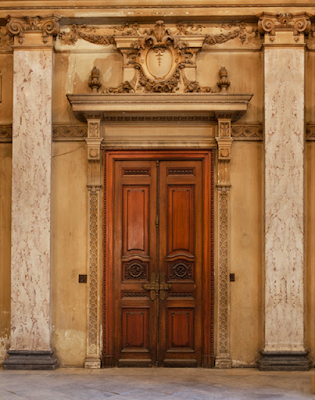 |
| Serageldin Palace |
It was
simple to purchase land from the Nile Land and Agriculture Company in 1905 and
hire Italian engineer Carlo Prampolini to create a home with balconies
overlooking the Nile on this tract of land because Credit Foncie Aegean is
known for being Egypt's first real estate finance bank. The palace's
construction was finished in 1908, starting in June 1906. Although Mr. Byerly
had already moved into the house in December 1908, he was not meant to live
there because he passed away from a heart attack three days later.
 |
| The Door of Palace |
Byerly's two
daughters rented the house to the German embassy after he passed just a few
days after entering the palace, and the German Emperor's travels to Egypt were
accommodated there. Britain put it under security when World War I started and
then lifted it when the conflict was over. It was sold to a Swedish family in
1919 when the Treaty of Versailles was signed, and they later converted it into
a boarding school for Egyptian upper-class children, but the endeavor was
unsuccessful.
 |
| Main Staircase |
Serag El-Din
Pasha Shahin, the father of Fouad Serag El-Din Pasha, purchased the palace in
1930 to present it to his wife, Mrs. Nabiha Hanem Badrawi, on their 25th
wedding anniversary. At the time, Serag Pasha was residing in El-Mubtadiyan and
desired to relocate his family, which consisted of six sons and two daughters,
to a larger home. He did purchase it, but he passed away in 1934, four years
later.
 |
| Fouad Serag El-Din Pasha |
The palace has 1800 square feet and 16 rooms, along with a lawn and garage. The selamlik,
which has four rooms, two bathrooms, and a nanny's room, is adjacent to the
palace, which was designed. It was intended for the family's children to remain
there until they turned ten. It prepared the family's children to remain in the
palace by teaching them table manners and conversation.
 |
| Fireplace |
One of
Garden City's most exquisite palaces, it was known as the family house. It had
a view of the Nile and was situated across from the Nahhas Pasha Palace.
Stained glass was used to adorn the palace's windows, and the best varieties of
Italian marble were imported. It included a marble fireplace and an old lift.
 |
| Staine Glass |
The
building's significance extends beyond its architectural merits; it is well
known for the significant political role that Fouad Pasha Serageldin, the
leader of the Wafd Party, performed there. The mansion served as the Wafd
Party's secret headquarters.
 |
Upper Floor
The palace
witnessed the visits of prominent figures, most notably the leader Saad
Zaghloul, Al-Naqrashi Pasha, Mustafa Al-Nahhas Pasha, and King Farouk, to
attend political meetings and social events. The Lady of Arabic Singing, UmmKulthum, also sang in it on special occasions for the Serag El-Din family, and
Muhammad Abdul Muttalib, Abdul Aziz Mahmoud, and Ismail Yassin also sang in it. Fouad Pasha Serag El-Din
did not object to allowing the house to be used for filming some scenes from
movies, such as “Ghroub Wa Shrouq”.
|
 |
Saad Zaghloul
|
 |
King Farouk
|
 |
| Umm Kulthum |
Regretfully,
it hasn't been listed as an ancient object. The Egyptian Ministry of
Antiquities is egregiously negligent in its registration of historic places.
Unfortunately, even though the Palace of Fouad Pasha Serag El-Din has been in
existence for more than a century, the Egyptian Ministry of Antiquities has not
yet registered it as an antiquity. This is true even though numerous palaces
satisfy the registration requirements, such as having a unique architectural
character or the owner having witnessed historical events.
 |
| Wrought iron gate |
 |
| Details of Gate |
Despite the
importance of the palace, it was sold to a wealthy Qatari figure, according to
sources very close to the Serag El-Din family, for an amount of about 110
million pounds, despite its historical and material value exceeding one billion
pounds.
 |
| A picture from inside the palace in 2006 |
 |
| Picture in 2011 |
“Neglecting
a historic palace like Serag El-Din Pasha Palace is a disaster by all
standards,” said archaeologist Dr. Ahmed Kamel El-Adham, expressing his opinion
on the Ministry of Antiquities’ position on Fouad Pasha Serag El-Din Palace. He
added that the Ministry of Antiquities has the right to expropriate any
building that has a unique style or to include it in the possession department
of the Supreme Council of Antiquities for permanent inspection and not to take
any measures to demolish it or change its features except with the knowledge of
the ministry. He pointed out that there are palaces and historic buildings that
are more than 100 years old are distinguished by a distinct architectural style
are associated with great historical figures and are not registered as an
antiquity until now, including Serag El-Din Pasha Palace.














